How is San Diego Doing in This Drought?
A drought emergency has been declared in Southern California amid dwindling water supplies in the region. NBC 7’s Audra Stafford has details on how San Diego County fairs in this predicament.
A drought emergency has been declared in Southern California amid dwindling water supplies in the region. NBC 7’s Audra Stafford has details on how San Diego County fairs in this predicament.
San Diego County and the rest of Southern California are under a new drought emergency announced this week. Local waters officials are encouraging conservation but say our local water supply is stable.
As California faces the prospect of a fourth consecutive dry year, officials with the Metropolitan Water District of Southern California have declared a regional drought emergency and called on water agencies to immediately reduce their use of all imported supplies.
The decision from MWD’s board came about eight months after officials declared a similar emergency for 7 million people who are dependent on supplies from the State Water Project, a vast network of reservoirs, canals and dams that convey water from Northern California. Residents reliant on California’s other major supply — the Colorado River — had not been included in that emergency declaration.
Lake San Marcos area homeowners associations are conserving water and helping restore the area’s watershed with support from the County of San Diego’s Watershed Rebate program. The rebate program is part of the County’s Watershed Protection Program.
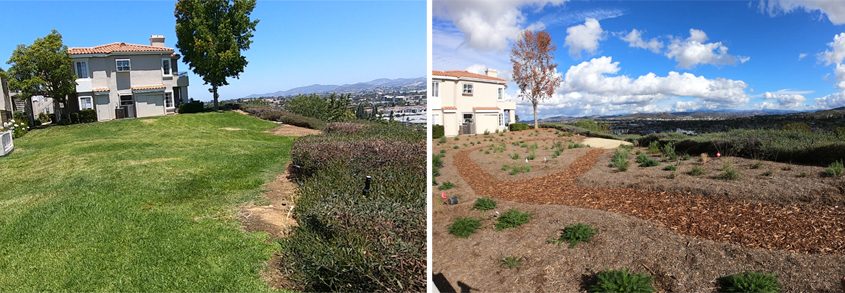
An example of the transformation of the Panorama HOA landscaping. Photos: Vallecitos Water District
Through a partnership between the program and the San Diego County Water Authority, residences and businesses in unincorporated areas of San Diego County are eligible for enhanced water-use efficiency rebates. The Waterscape Rebate Program saves money for residential, commercial, and agricultural customers who make landscape upgrades to improve the region’s climate resilience and reduce the flow of pollutants into waterways.
The Panorama HOA in Lake San Marcos is one of six HOAs in the Vallecitos Water District participating in the program. The project is featured in a new video produced by Vallecitos.
“While droughts are cyclical, now they’re hotter and drier and lasting a lot longer,” said Joni German, water resources specialist at the Water Authority. “The Water Authority looks to our partners like the County of San Diego’s Watershed Protection Program to help us meet these challenges.”
“This project here in Lake San Marcos is a great example of a successful turf conversion project, supported by multiple agencies through the Landscape Optimization Service, said German. “Panorama HOA removed 30,000 square feet of thirsty turf and replaced it with sustainable landscaping, including 14,000 square feet of native landscape.”
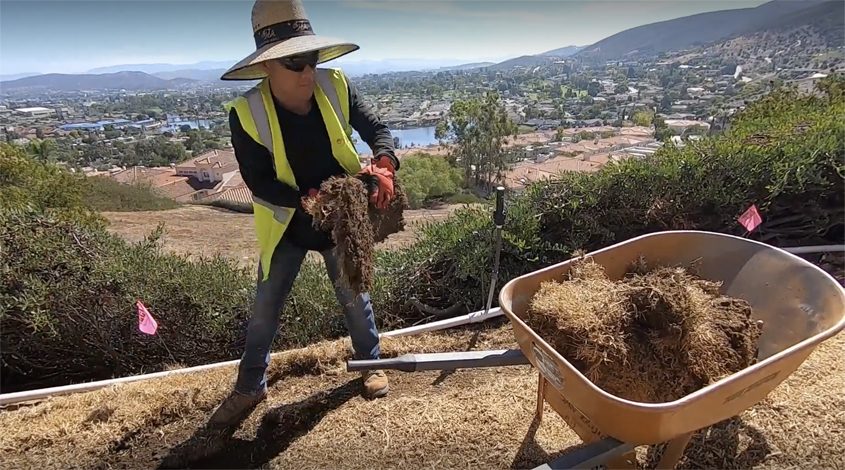
Removing turf yields multiple benefits including water conservation, watershed protection, and potential cost savings. Photo: Vallecitos Water District
Sustainable landscapes produce multiple benefits, which include reducing water use, enhancing habitat, increasing stormwater retention, and decreasing runoff.
To make applying for rebates easier for large landscapes, the County created the Landscape Optimization Service (LOS), a unique technical assistance program for large-scale landscaping projects. The program helps applicants with large landscapes, such as HOAs and commercial properties, to navigate the requirements, overcome any barriers, and maximize their rebate eligibility.
“It’s a service offered free to large landscapes. It helps them get the most from the rebates that are available,” said Jamie Milani, land use planner for the Watershed Protection Program. “Throughout the process, we are always here for our customers. If there’s ever any challenges with the rebate application process, we’re here to help.”
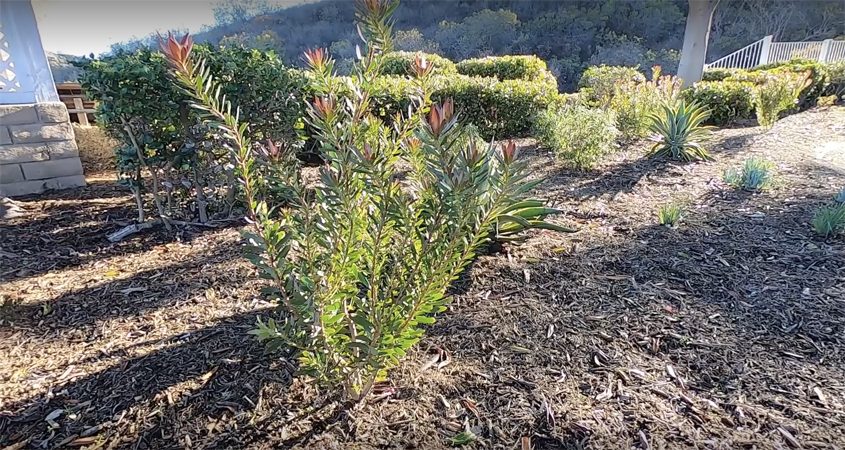
The new landscaping uses California native plants, which are eligible for an additional rebate. Photo: Vallecitos Water District
LOS staff analyzes estimated water and cost savings, including anticipated rebate totals, which helps decision-makers justify the investment with an understanding of how quickly the project will pay for itself. The program also offers discounted landscape design services to participants.
Rebate amounts can vary. Multiple rebates can be stacked together, including $3 per square foot for turf replacement, $60 per smart controller station, $65 per rain barrel, and up to $450 per cistern. The County program also offers $1 per square foot for landscapes planted with California native plants.
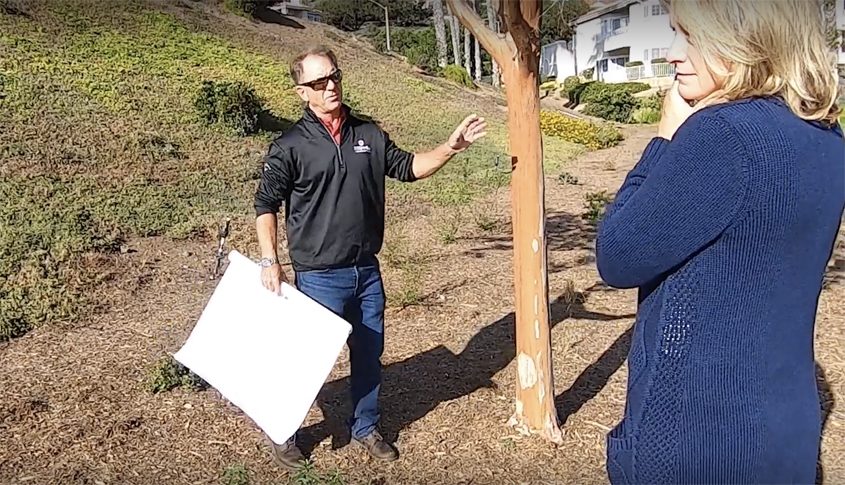
Jack Rush, vice president of operations for O’Connell Landscape Maintenance, discusses the makeover plan with Panorama HOA President Amber Rugghanti. Photo: Vallecitos Water District
Panorama HOA President Amber Ragghanti said members decided to participate in the program due to its landscaping aging out and the opportunity to secure assistance from the program, along with the rebates.
“The residents at Panorama were really happy with the process, especially because there was no cost,” said Ragghanti. “A lot of the people living here are also concerned about saving water.”
Ragghanti encourages other qualified HOAs to look into the program. “It’s been such a benefit. It’s been easy. The whole process has been a lot smoother than I thought it would be. I would recommend it to anybody.”
Water customers in unincorporated San Diego County can determine their eligibility at: WatershedRebates. More information on the Landscape Optimization Service can be found here.
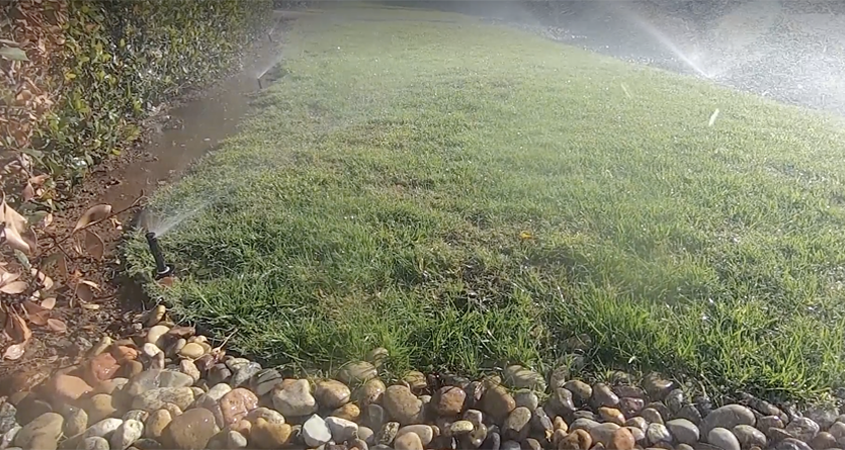
When irrigation systems overflow from landscaping, runoff may carry pollutants like pesticides, herbicides, and fertilizers into the storm drain system. Photo: Vallecitos Water District
The Waterscape Rebate Program helps protect local waterways by reducing pollutants that enter storm drains. When irrigation systems overflow from landscaping, runoff may carry pollutants like pesticides, herbicides, and fertilizers into the storm drain system. Reducing turf helps reduce irrigation use and runoff.
(Editors Note: Story updated March 22, 2023. The Vallecitos Water District is one of the San Diego County Water Authority’s 24 member agencies that deliver water across the metropolitan San Diego region.)
California’s Department of Water Resources announced that it has awarded $86 million in financial assistance to meet the immediate and long-term water needs for millions of Californians. The department is providing $44 million to its Small Community Drought Relief Program and $42 million to its Integrational Regional Water Management Program.
After three years of virtual events, the PPIC Water Policy Center’s annual fall conference made a welcome return to an in-person format in Sacramento on Friday, November 18. The half-day event began with a welcome from PPIC Water Policy Center assistant director Caity Peterson and a presentation by senior fellow Jeffrey Mount.
This year was “brutal” for agriculture, said Thad Bettner of the Glenn-Colusa Irrigation District during the first panel, moderated by PPIC Water senior fellow Alvar Escriva-Bou. “We took about 300 square miles out of production.” The drought hit rural and urban communities hard, too: Kyle Jones of the Community Water Center said that “over 1,300 [drinking water] wells went dry.” Bill Hasencamp of Metropolitan Water District described in vivid detail how once-reliable water management strategies are failing, in part due to a lack of interconnections: his agency had to restrict deliveries to “one-third of our service area despite having a record amount of dry-year storage reserves.”
The environment suffered as well, though Sandi Matsumoto of The Nature Conservancy praised the State Water Board, River Partners, and others for efforts to aid wildlife. Well-timed curtailments in some basins, she said, were helpful. But the stakes are high, she said: “Over half of California’s salmon and steelhead species are on a trajectory towards extinction.” And as Hasencamp put it, “drought and climate change have outstripped us.”
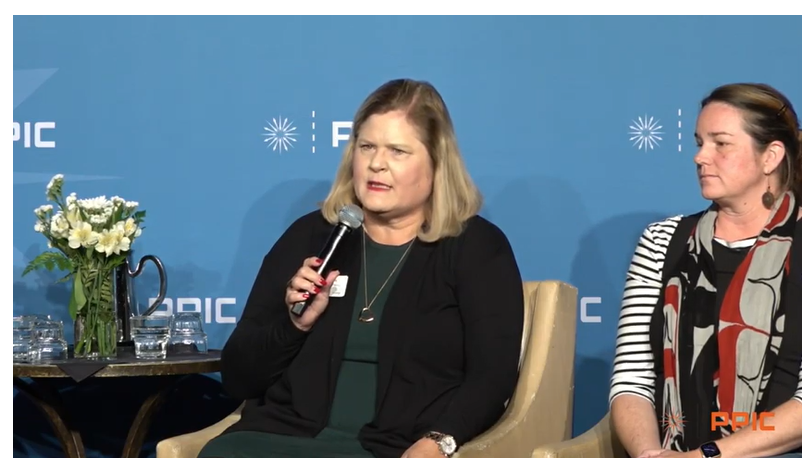
Sandra Kerl commended Scripps Institution of Oceanography for their “game-changing” atmospheric river forecasts—and panelists highlighted the promise of Forecast-Informed Reservoir Operations (FIRO) as a tool to make the most of storage infrastructure. Photo: Screenshot from PPIC Water Policy Center annual fall conference Nov. 18.
Capturing more water during wet periods will help California weather the dry periods, said participants in the second panel, moderated by research fellow Andrew Ayres. Sandy Kerl of the San Diego County Water Authority said that investing in reservoir capacity was key after the county suffered a crippling drought in the late ‘80s. “We now have enough storage capacity…to sustain the population at a 75% service level for six months,” she said.
Socking water away in underground water banks is another important strategy, said Mike Tognolini of EBMUD. Such projects rely on good relationships. After some early missteps in a water banking pilot project, he said “we [now] have solid partnerships with local water agencies in San Joaquin County and, importantly…with growers in the region.”
Aaron Fukuda of the Tulare Irrigation District emphasized the importance of trust-building too. “I tell everybody when you want to strike up a partnership, just take them out to dinner,” he said, to laughter. Groundwater recharge works best when relationships are formed first, and how you approach water right holders matters, he said. “When you ask a farmer for help, they will help.”
Kerl commended Scripps Institution of Oceanography for their “game-changing” atmospheric river forecasts—and panelists highlighted the promise of Forecast-Informed Reservoir Operations (FIRO) as a tool to make the most of storage infrastructure. Local agencies are also making good progress in accounting for water once it’s in the ground—key to facilitating more water banking projects.
And, as Julie Rentner of River Partners noted, the stakes for managing the increasingly flood-prone wet periods of our changing climate could not be higher. In 1997, the San Joaquin Valley was hit by a flood that broke the valley’s flood control system in 17 places. Climate projections show that a flood three to five times that magnitude “will likely hit the San Joaquin Valley in our lifetimes.” The damage, she said, would be incalculable. But California’s “new Central Valley flood-protection plan…takes a solid look at multi-benefit projects” that slow floods, recharge groundwater, and support habitat restoration.
The day’s final panel looked at policy’s role in responding to climate conditions. PPIC Water Policy Center director Ellen Hanak sat down with California Department of Water Resources director Karla Nemeth, State Water Board chair E. Joaquín Esquivel, and US Army Civil Works Program assistant secretary Mike Connor. Hanak asked these policy heavy-hitters to share progress and gaps in “this moment of climate whiplash.”
“We’re now in a moment where it’s like ‘Everything, Everywhere, All at Once,’” said Karla Nemeth. “We’re in a multiverse….everything is moving.” Hotter temperatures have now become “their own water demand,” she said, and Californians need to embrace water recycling, desalination, recharge, and conservation—all while keeping water affordable. But California also needs to think big, she said. “We can’t be afraid of taking out big infrastructure or putting in big infrastructure.” As an example of the former, she noted progress on removal of the dams on the Klamath River. And for the latter, she noted that “the Delta conveyance project is enormously important to climate adaptation.”
Esquivel said that water projects that were state-of-the-art 50 years ago now find themselves “mismatched for the climate that we have.” While data has improved, “data alone is not enough. It has to turn into better decision making.” A “greater fidelity to reality,” he said, will be essential. He said compliance across multiple basins with water right curtailments is heartening. “People want to use rights in ways that help support the resilience of us all.”
Mike Connor shared that much of the country still struggles to understand how profoundly conditions have changed. In one eight-week period this summer, he said, “there were six one-in-one-thousand-year precipitation events across the continental US.” He said that “restoring hydrologic function wherever we can…always adds to water availability by keeping it in the system.” All panelists agreed that increased funding, including from the recently passed Inflation Reduction Act, will be a boon to efforts.
We invite you to watch the videos from this event:
(Editor’s Note: Permission to republish blog post granted by PPIC Water Policy Center)
Rincon del Diablo Municipal Water District reports that it completed an initiative to provide nearly $1.2 million in rebates to customers and has received overwhelmingly positive feedback about the program.
Rincon del Diablo Municipal Water District reports that it completed an initiative to provide nearly $1.2 million in rebates to customers and has received overwhelmingly positive feedback about the program.
The rebates were made possible following years of litigation by the San Diego County Water Authority against the Metropolitan Water District of Southern California for violating existing exchange agreements between the two agencies. The customer rebates come as residents across the county prepare for the holiday season, giving Rincon Water customers a boost to help put food on the Thanksgiving table and some extra gifts for family members next month.
“When the San Diego County Water Authority won their lawsuits against the Metropolitan Water District of Southern California, we had to decide on what to do with about $1.2 million that was returned to us,” said Clint Baze, General Manager of Rincon Water. “The Rincon Board of Directors said the decision was easy because the money belongs to our customers and that is where it should go. It was the right decision, and it reflects our values of integrity, transparency, and fiscal accountability.”
The Water Authority’s lawsuit against MWD resulted in the SDCWA disbursing over $90 million to 24 member agencies, including Rincon Water. The SDCWA suit was filed against MWD in an effort to remedy overcharges from 2011-2017.
Located in northern San Diego County, Rincon Water is an urban water district consisting of more than 8,600 metered connections, of which 89% are residential customers. Its industrial customers include companies ranging from a high-tech trauma hospital, a nationally popular brewery, and a large vital utility, among others.
“We take our obligations to our customers seriously – in this case, it meant returning the money as fairly and efficiently as possible, thereby giving the customer the ability to make the decision on how to spend it rather than absorbing it into the budget,” Baze said. “Rincon Water continues to lead through our excellent customer service, our top-tier water and wastewater system, and our commitment to building a sustainable system for the future.”
Rincon Water provides safe and reliable potable and recycled water to a population of 32,000 people through more than 8,000 customer connections. Our potable distribution system consists of nine enclosed reservoirs with the storage capacity of 22.5 million gallons. The potable water system consists of over 117 miles of 8″ or bigger pipeline and four pump stations and has a peak production of 10 million gallons per day.
(Editor’s note: The Rincon del Diablo Municipal Water District is one of the San Diego County Water Authority’s 24 member agencies that deliver water across the metropolitan San Diego region.)
The San Diego County Water Authority has been named a Top Workplace for 2022 by The San Diego Union-Tribune – the second straight year the agency has been recognized. The newspaper’s honor roll is based solely on employee feedback through third-party surveys by Energage LLC, an employee engagement technology firm.
San Diego County Water Authority board member Lois Fong-Sakai has been elected secretary of the Board of Directors of the Metropolitan Water District of Southern California. Fong-Sakai, who represents the City of San Diego on the Water Authority board, is a registered civil engineer in California and Nevada. She becomes the first Asian-American to service on the board of the Los Angeles-based water wholesaler serving nearly 19 million people in six counties.
“It’s a great honor to serve not only San Diego County, but all of Southern California,” said Fong-Sakai. “Extreme drought conditions create significant challenges that will be best addressed through collaboration and cooperation across the region.”
Fong-Sakai has served on the Water Authority board since April 2015 and is one of four Water Authority delegates on the 38-member MWD Board of Directors, which represents 26 member agencies in Southern California.
Fong-Sakai says her new role may expand to take advantage of her expertise as a parliamentarian and member of the National Association of Parliamentarians for 35 years.
“I’m hopeful that I can help with running more efficient meetings,” said Fong-Sakai. “Parliamentary procedure is not a lot of stuffy rules about how meetings should be run. It allows all voices and opinions to be heard respectfully, including those of the minority positions. With open and inclusive discussions and debate, we, as an organization can only be stronger.”
In remarks accepting her new position, Fong-Sakai shared her family history, from her Chinese American and Japanese American relatives who first came to the U.S.in the 1850s and embraced democracy despite widespread discrimination. Nearly a century later, Fong-Sakai’s Japanese-Americans relatives, American citizens and legal residents, were forcibly moved to internment camps where they remained for three years following the attack at Pearl Harbor.
As part of her new role, Fong-Sakai is passionate about ensuring everyone has a voice. “As secretary, I will seek to allow all voices and opinions to be heard respectfully, including those of minority positions,” she said. “Open and inclusive discussions will make Metropolitan stronger and benefit everyone in Southern California.”
Fong-Sakai closed her remarks by sharing a Chinese proverb. “’One chopstick is easily broken, while a bundle of chopsticks is not.’ Indeed, when we work together, we are indeed greater and stronger than the sum of its parts.”
Fong-Sakai has more than three decades of experience in water planning and policy including work as a project manager and engineer for major water projects for the West Basin and Central Basin water districts, and the industrial wastewater treatment plant at San Francisco International Airport.
She helps raise funds to plan, design, and build sustainable water systems in nine developing nations as a member of the American Water Works Association’s Water for People charitable organization. Fong-Sakai is past president and a current member of the Society of Women Engineers, California Water Environment Association, and the Asian Business Association. For the past 25 years, she has volunteered with the foster organizations Polinsky Childrens’ Center and Promises2Kids, and was named San Diego County’s 2020 Volunteer of the Year.
Fong-Sakai is the Chief Financial Officer at Jade Coast Software, Inc., a business she owns with her husband Willie. She is a member of Professional Photographers of San Diego County and Senior Coordinator of the International Exhibition of Photography at the San Diego County Fair. She earned both her master’s degree in civil and environmental engineering and bachelor’s degree in chemistry from University of California, Berkeley.
